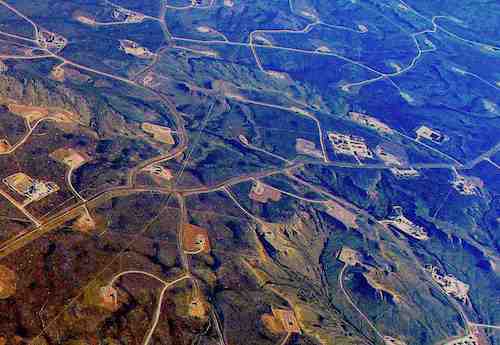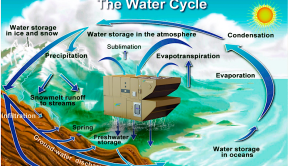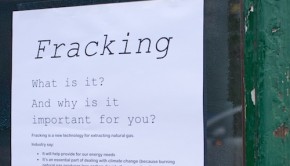Fracking’s Slow-Motion Train Wreck Revealed In New Report
October 27th, 2014 by Tina Casey
If you are one of those people who smell the stench of bust behind today’s fracking-fueled oil and gas boom, the Post Carbon Institute has an early Christmas present for you. In its latest report, the organization makes the case that US shale oil and gas reserves will peak and drop off rapidly, long before officially predicted by the US Energy Information Agency.
The new Post Carbon Institute report is titled “Drilling Deeper: A Reality Check on U.S. Government Forecasts for a Lasting Tight Oil & Shale Gas Boom.” It was prepared by the same consultant who correctly predicted that official estimates of oil reserves in California’s Monterey Shale 1 formation would fall off the cliff.

Fracking operations (cropped and altered) courtesy of Simon Fraser University.
Fracking’s Great Moment of Derp: Monterey Shale
Post Carbon’s Monterey shale oil report came out in December 2013. Titled Drilling California: A Reality Check on the Monterey Shale, it picked apart an optimistic projection made by the US Energy Information Agency in 2011 to the tune of 13.7 billion barrels.
Post Carbon argued that EIA put too much weight on experience with the Bakken and Eagle Ford shale operations, and did not factor in variations in the Monterey formation.
By May 2014 the chickens had come home to roost, when a new EIA estimate dropped the estimate down by 96 percent, to about 600 million barrels.
The New Post Carbon Fracking Report
With that in mind, let’s take a look at “Drilling Deeper,” which was just released earlier this morning.
The report examines EIA’s forecasts for 12 shale plays that together cover 82% of tight oil (tight oil refers to oil recovered from shale formations, not to be confused with oil shale) and 88% of shale gas production.
Basically, Post Carbon finds the same “extremely optimistic” outlook at work.
Although the report predicts fairly robust activity in the near term, it predicts that tight oil will be far lower than the EIA predicts over its 2040 timeline, absent the discovery of significant new plays.
Here’s a sample of the findings for oil:
Tight oil production from the two top plays, the Bakken and Eagle Ford, will underperform the EIA’s reference case oil recovery by 28% from 2013 to 2040…By 2040, production rates from the Bakken and Eagle Ford will be less than a tenth of that projected by the EIA.
The outlook for shale gas doesn’t look much rosier. Without the discovery of major new shale formations, here’s the projection from the Post Carbon report:
Shale gas production from the top seven plays will underperform the EIA’s reference case forecast by 39% from 2014 to 2040…By 2040, production rates from these plays will be about one-third that of the EIA forecast.
Fracking Boom, Fracking Bust, and The New Ghost Towns
The new Post Carbon report is focused on the impact that shale play estimates have on US energy policy. Press materials for the report also describe the financial symptoms of a bubble that’s about to pop.
However, we’re more interested in the report’s implications for communities and individual property owners that host fracking or fracking wastewater disposal operations.
Those of you who know your Westerns are familiar with the “ghost town” phenomenon of abandoned mining communities that lost their raison d’être once the mining company pulls out.
In real life, the ghost town effect doesn’t just mean a loss of employment. It can also saddle the community with a toxic environmental legacy that thwarts new economic activity.
You could make the case that mining boom towns wouldn’t have existed in the first place if it wasn’t for the mine, so no foul, no harm. But that doesn’t apply to the current oil and gas fracking boom. In many areas it is intruding into established communities that already have a firm footing in sectors like agriculture or tourism, or that have the potential for long term economic grown.
The Post Carbon report underscores that the fracking boom is just that: a relatively short-lived boom. Given emerging evidence of the negative impacts of fracking and fracking wastewater disposal, communities that already host a healthy economic platform would be well served to pass on the opportunity to make a quick buck, and focus on more long term, sustainable sources of income.
For those of you new to the topic, those impacts are only just beginning to emerge because for many years fracking (short for hydrofracturing, a longstanding but formerly uncommon method for recovering oil and gas from shale formations) was largely confined to thinly populated areas in the western US, where it attracted little attention from the outside world.
However, a Bush-era exemption from federal water protection regulations has enabled thousands of fracking rigs to blossom in new territory, including the heavily populated northeastern and mid-Atlantic states.
As a result, fracking has become an incendiary issue for some communities, as has fracking wastewater disposal. That’s on top of the meta-issue, which is the role of natural gas in climate change.
We’re already beginning to see significant pushback against fracking on the local level, particularly in fracking hotspot Pennsylvania as well as in New York State, where communities are deploying their zoning authority.
Stay tuned.
Keep up to date with all the hottest cleantech news by subscribing to our (free) cleantech newsletter, or keep an eye on sector-specific news by getting our (also free) solar energy newsletter, electric vehicle newsletter, or wind energy newsletter.
-
rockyredneck
-
Offgridman
-
rockyredneck
-
Bob_Wallace
-
rockyredneck
-
Offgridman
-
rockyredneck
-
Offgridman
-
rockyredneck
-
-
Offgridman
-
rockyredneck
-
Offgridman
-
rockyredneck
-
-
-
-
-
Offgridman
-
S Morris
-
Offgridman
-
Offgridman
-
-
-
Bob_Wallace
-
S Morris
-
Bob_Wallace
-
S Morris
-
Bob_Wallace
-
S Morris
-
Bob_Wallace
-
S Morris
-
Bob_Wallace
-
-
Gene_Frenkle
-
Bob_Wallace
-
Gene_Frenkle
-
Bob_Wallace
-
Lynne Whelden
-
S Morris
-
-
-
-
-
https://www.facebook.com/CREEP.org?ref=hl Mark Richardson
-
S Morris
-
Hans
-
-
-
S Morris
-
Gene_Frenkle
-
S Morris
-
Offgridman
-
S Morris
-
Gene_Frenkle
-
S Morris
-
Offgridman
-
Gene_Frenkle
-
Offgridman
-
-
-
-
Lynne Whelden
-
JD234
-
Joseph Dubeau
-
-
Lynne Whelden
-
S Morris
-
-
Shane 2
-
Joseph Dubeau
-
David in Bushwick
-
The8thDwarf
-
Offgridman
-
Mint
-
Bob_Wallace
-
Offgridman
-
Bob_Wallace
-
Offgridman
-
Mint
-
Bob_Wallace
-
Mint
-
-
-
-
-
http://www.michaeljberndtson.com/ Michael Berndtson

























